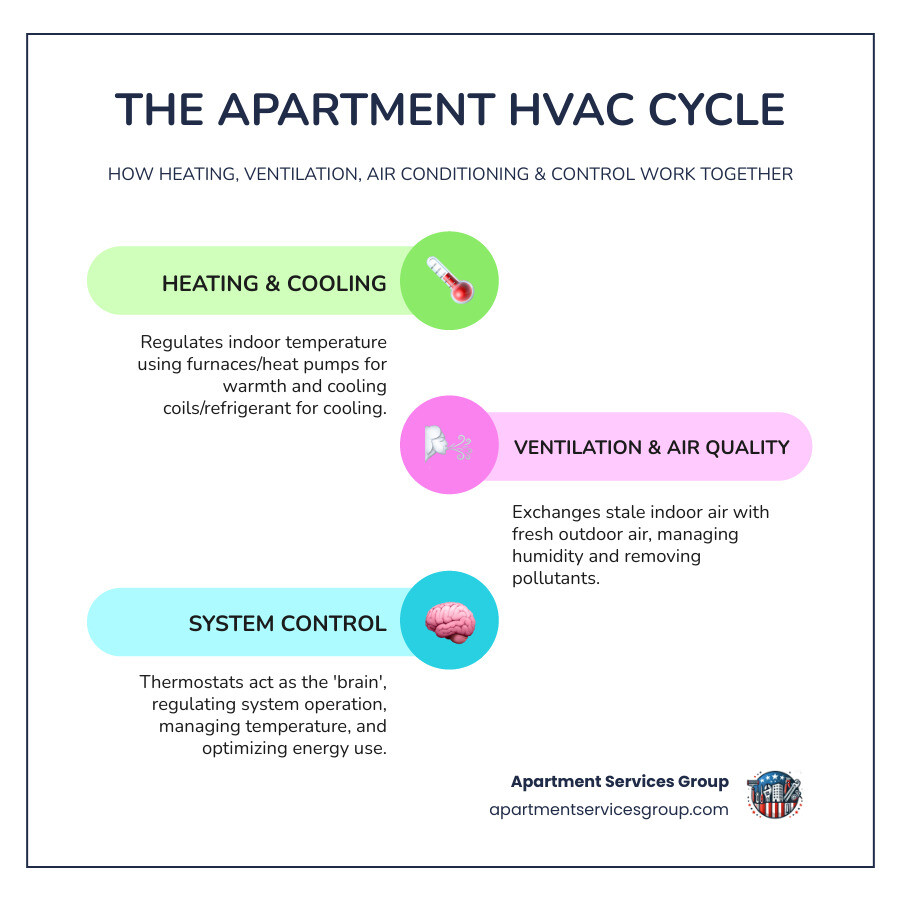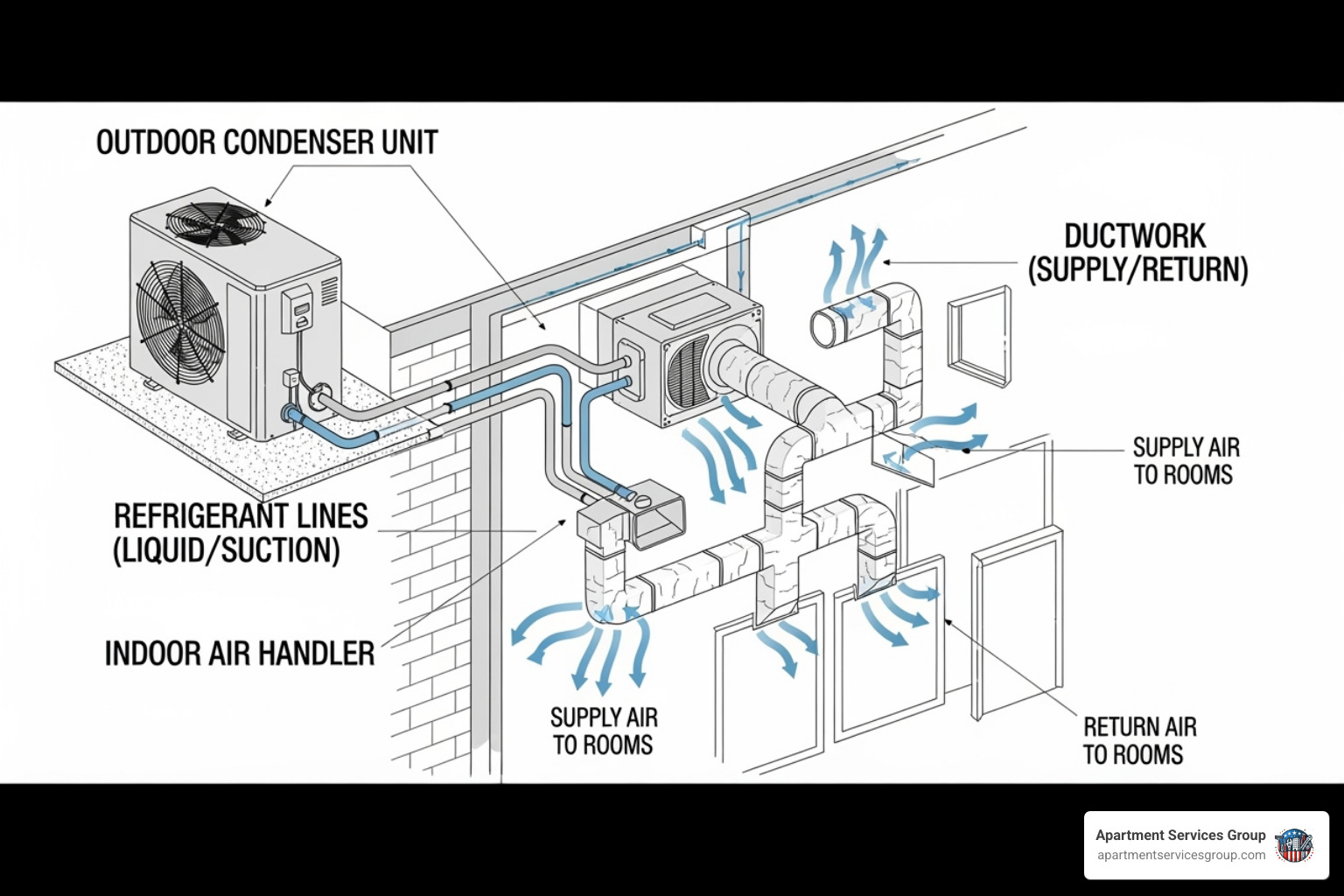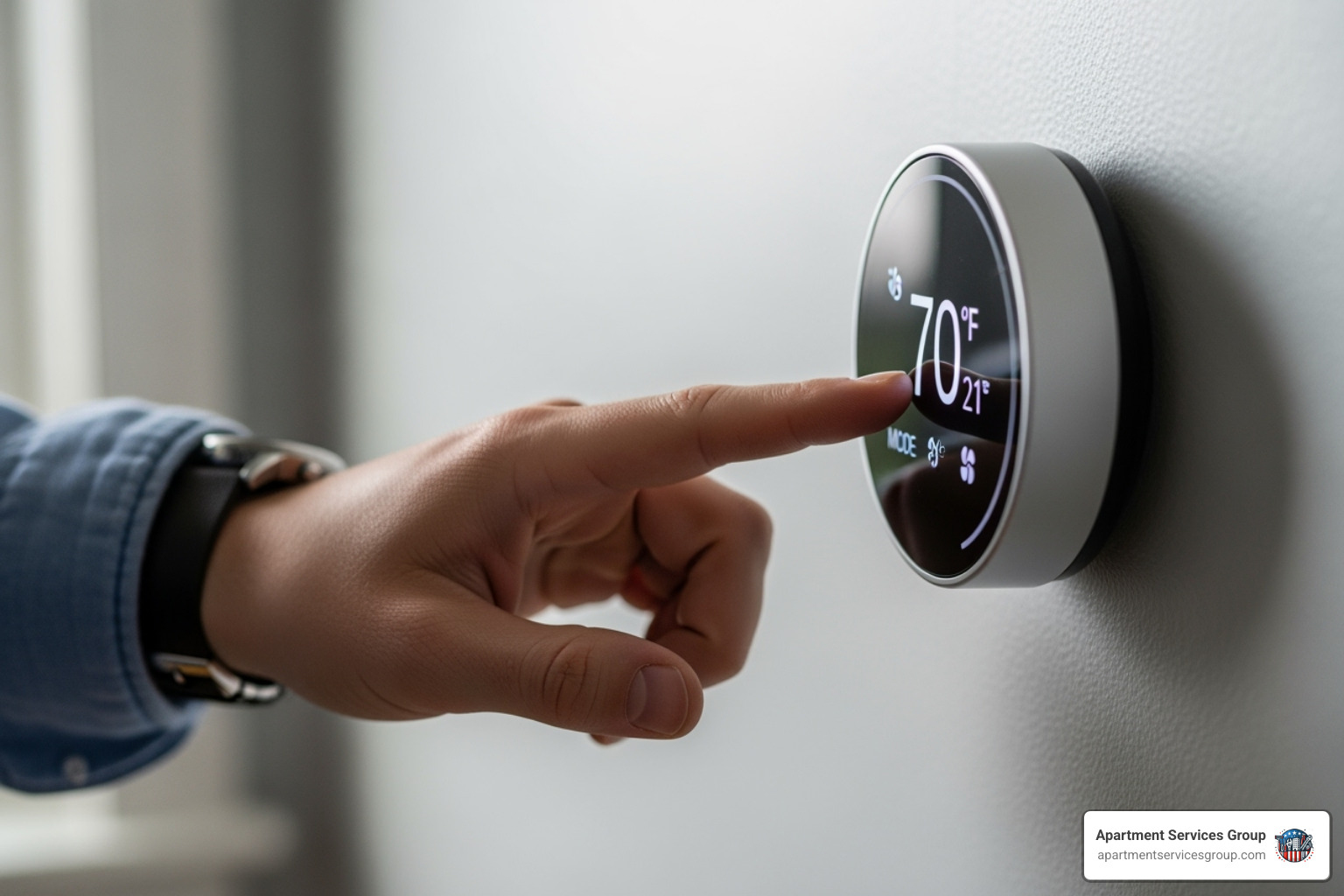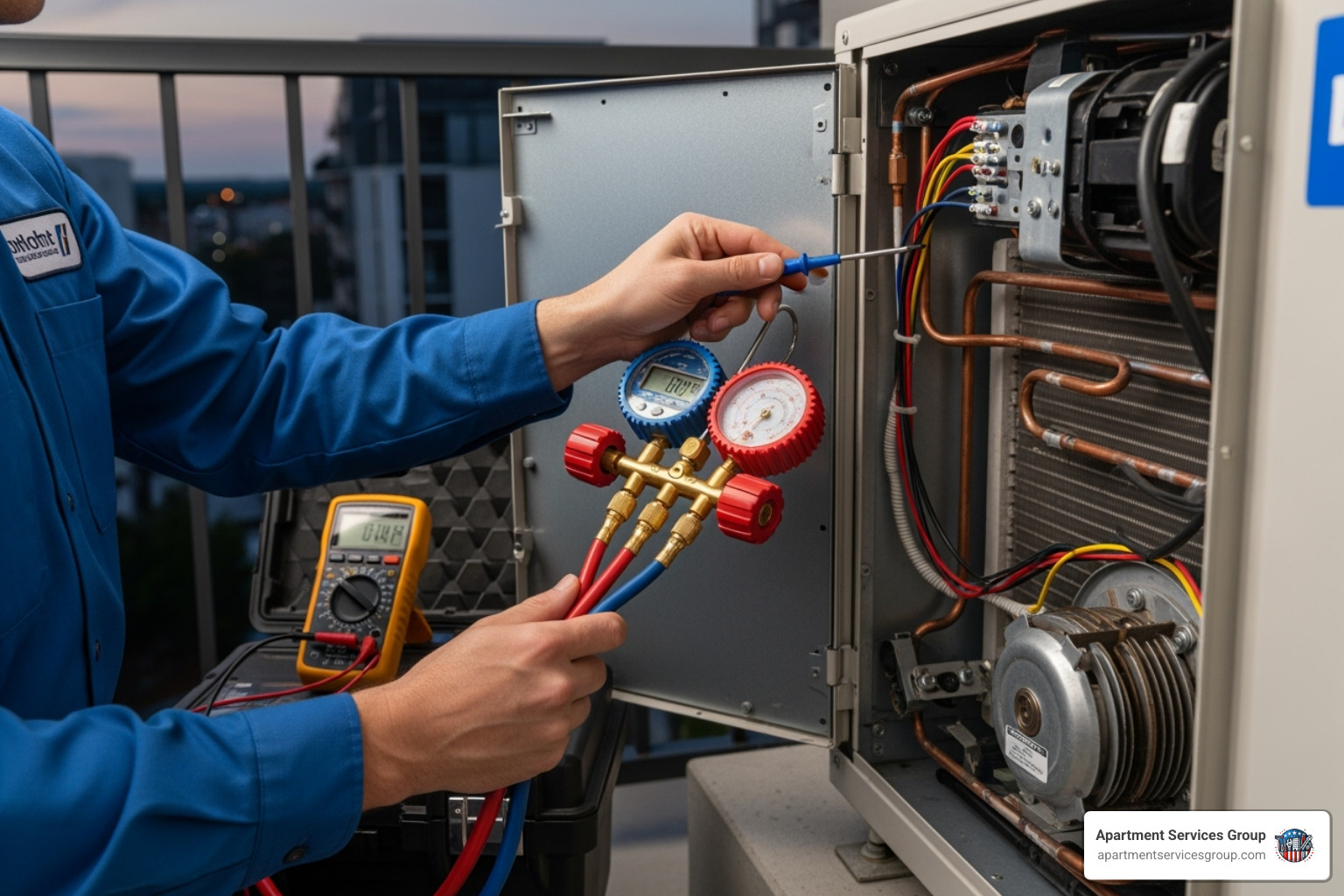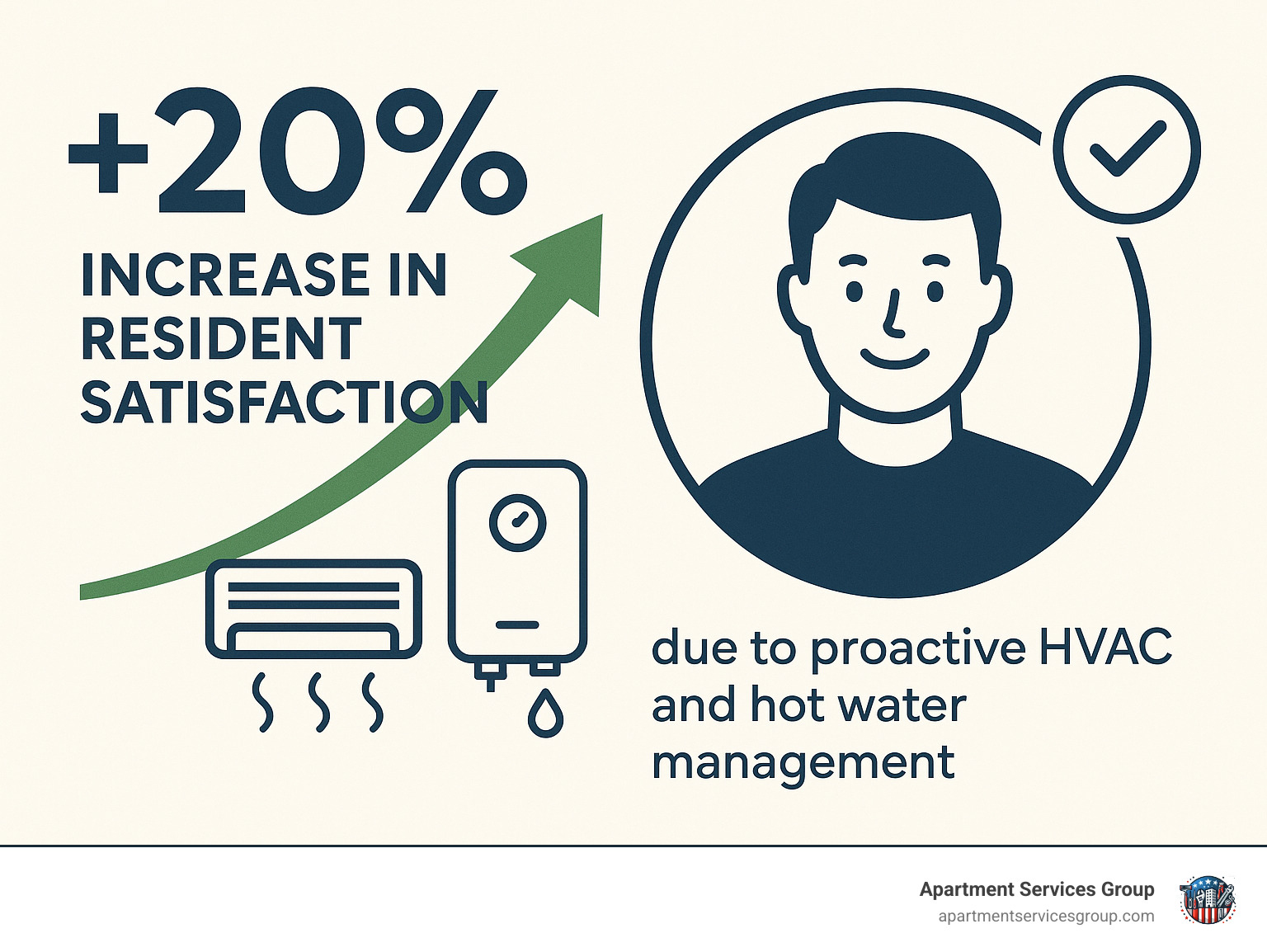Apartment HVAC Repair: Ultimate 2025 Guide
Why Apartment HVAC Repair Should Be Your Top Priority
Apartment HVAC repair is critical for maintaining tenant comfort, controlling energy costs, and preventing costly emergency breakdowns that can impact multiple units at once. Whether you manage a single building or multiple properties, understanding your HVAC system is essential for successful property management.
Quick Answer for Property Managers:
- Centralized systems affect multiple units when they fail but are easier to maintain
- Decentralized systems only impact individual units during repairs but require more maintenance points
- Regular maintenance can increase resident satisfaction by 20% and prevent expensive emergency repairs
- Professional service is recommended for complex repairs, while basic tasks like filter changes can be handled in-house
The stakes are high when it comes to apartment HVAC systems. Research shows that an average of 45,900 heating fires occur in residential buildings yearly, resulting in 205 deaths, 725 injuries, and $506 million in property loss. These statistics highlight why proper maintenance and timely repairs aren’t just about comfort – they’re about safety and protecting your investment.
For property managers, HVAC issues can quickly become tenant retention problems. When residents experience inconsistent temperatures, poor air quality, or complete system failures, their satisfaction drops dramatically. On the flip side, proactive HVAC management can boost resident satisfaction by 20 percent, making it one of the most impactful investments you can make in your property.
I’m Moe Shariff, owner of Apartment Services Group and multiple service companies in Houston with over eight years of experience in property management solutions. Through managing comprehensive maintenance programs, I’ve seen how proper Apartment HVAC repair strategies can transform both operational costs and tenant relationships. Let’s explore everything you need to know to keep your systems running smoothly.
Understanding Apartment HVAC Systems: Centralized vs. Decentralized
Picture this: it’s the hottest day of summer in Houston, and your apartment complex’s HVAC system decides to take a vacation. The difference between a centralized and decentralized system could mean the difference between fixing one unit and having happy tenants in an hour, or dealing with 50 angry residents whose air conditioning just went out all at once.
Centralized systems are like the heart of your building – one big system pumping comfort to everyone. You’ll typically see a large chiller unit on the roof or a massive boiler in the basement doing all the heavy lifting. These systems send heated or cooled air through shared ductwork that snakes throughout the building, reaching every apartment unit.
Decentralized systems work more like individual lungs for each apartment. Every unit has its own heating and cooling equipment, whether that’s a furnace and AC unit tucked away in a closet, a PTAC unit mounted through the wall, or a sleek ductless mini-split system.
For property owners, this choice affects everything from your monthly energy bills to how happy your tenants are. If you include utilities in rent, centralized systems give you more control over energy costs since tenants can’t crank up their individual units without thinking about the bill. But here’s the trade-off – some residents will always be too hot while others are too cold, and that can lead to maintenance requests and frustrated phone calls.
The tenant experience tells a different story with decentralized systems. Everyone gets to control their own comfort, which usually means happier residents and fewer complaints. However, if tenants pay their own utilities, you might see some sky-high energy bills that could impact renewals. For comprehensive solutions that balance both approaches, check out our Apartment Complex Solutions.
The Core Differences
When we look under the hood, these systems operate in fundamentally different ways that impact your apartment HVAC repair strategy.
Centralized systems rely on powerhouse equipment like chiller units for cooling and boilers for heating. Think of them as the engines of a train – when they’re running well, everyone’s comfortable. The heated or cooled air travels through shared infrastructure like extensive ductwork or piping systems that connect every apartment.
The challenge comes when something goes wrong. A single failure can knock out climate control for dozens of units simultaneously, creating an urgent apartment HVAC repair situation that affects your entire building’s satisfaction scores.
Decentralized systems spread the risk around with individual units serving each apartment. You might have PTAC units – those self-contained boxes that sit under windows and handle both heating and cooling for one room. They’re simple, reliable, and give tenants complete control over their comfort.
Another popular option is ductless mini-split systems, which pair an outdoor compressor with indoor units connected by a small conduit. These systems are incredibly efficient and perfect for unit-specific control without the need for extensive ductwork modifications.
The beauty of decentralized systems is that when one unit fails, it only affects one apartment. Your maintenance team can focus on solving one tenant’s problem instead of fielding calls from half the building.
Advantages and Disadvantages of Centralized vs. Decentralized HVAC
| Feature | Centralized System | Decentralized System |
|---|---|---|
| Maintenance | Simpler to service one system | Multiple units to service |
| Repair Impact | Failure affects multiple units | Failure affects a single unit |
| Tenant Control | Limited or no individual control | Full individual control |
| Utility Costs | Easier for owners to manage/include in rent | Higher potential for overuse by tenants |
| Installation | Complex initial installation | Simpler, unit-by-unit installation |
The choice between these systems often comes down to your property’s specific needs and management style. Centralized systems can simplify your maintenance schedule since you’re dealing with fewer, larger pieces of equipment. But when they break, the impact is immediate and widespread.
Decentralized systems require more coordination since you’re managing multiple units, but they offer flexibility and tenant satisfaction that can significantly improve retention rates. Plus, when maintenance issues arise, you’re typically dealing with one unhappy resident instead of an entire building full of them.
Key Components and How They Function
No matter what type of HVAC system your apartment building uses, they all work with the same basic principles. Think of HVAC as three friends working together: Heating keeps everyone cozy in winter, Ventilation makes sure the air stays fresh and healthy, and Air Conditioning provides blessed relief from Houston’s legendary heat. Understanding how these components function together makes apartment HVAC repair much more manageable and helps you spot problems before they become expensive emergencies.
Heating: Keeping Residents Warm
When temperatures drop, your heating system becomes the hero of tenant comfort. Most apartments rely on forced-air systems, where a furnace heats air and pushes it through ductwork to every room. These systems work fast and keep temperatures even throughout the unit, though they can be a bit noisy when they kick on.
Some older buildings still use radiant heating, which circulates hot water through pipes in the floors or walls. These systems are whisper-quiet and create incredibly comfortable, even heat. They’re also energy-efficient, though they take longer to warm up a cold space.
Heat pumps are becoming increasingly popular because they’re like getting two systems for the price of one. In winter, they pull heat from outside air (yes, even cold air has some heat in it!) and move it indoors. In summer, they reverse the process and work like an air conditioner. They’re particularly energy-efficient, which helps keep utility costs manageable.
Ventilation: The Importance of Fresh Air
Ventilation might not get much attention from tenants, but it’s absolutely critical for healthy living. Without proper airflow, apartments become stuffy, humid, and can develop serious air quality problems that lead to tenant complaints and health issues.
Indoor air quality depends entirely on good ventilation. The system constantly removes pollutants, allergens, excess moisture, and even carbon dioxide that builds up from normal breathing. This is especially important in modern, well-sealed apartments where contaminants can’t escape naturally.
Your exhaust systems work overtime in kitchens and bathrooms. Range hoods pull out cooking smoke and grease, while bathroom fans prevent the humidity that leads to mold growth. Meanwhile, fresh-air intakes bring in clean, filtered outdoor air to replace what’s been removed.
Proper ventilation is your best defense against mold prevention. By controlling humidity levels, these systems protect both your building investment and tenant health. Good ventilation also plays a crucial role in fire safety – clean ducts and proper airflow reduce fire risks significantly. The National Fire Protection Association provides excellent resources on fire prevention and HVAC risk maintenance.
Air Conditioning: The Science of Cool
In Houston, air conditioning isn’t a luxury – it’s a necessity for tenant retention. The science behind cooling is actually pretty fascinating: your AC system doesn’t create cold air, it removes heat and humidity from indoor air and dumps it outside.
Here’s how it works: refrigerant circulates through a closed loop system. Indoor cooling coils absorb heat from your apartment’s air, turning the liquid refrigerant into gas. This heated gas travels to the outdoor condenser, where the heat gets released into the outside air, and the refrigerant turns back into liquid. The cycle repeats continuously.
Central air conditioning systems in larger buildings often use massive chiller units that cool water instead of air directly. This chilled water then circulates to individual air handlers in each apartment. For detailed information about central air conditioning, the Department of Energy offers comprehensive guides.
Split AC systems are more common in individual apartments. You’ll see the outdoor condensing unit (usually on a balcony or outside wall) connected to an indoor air handler. These systems are efficient and give tenants direct control over their comfort.
Don’t forget about humidity control – removing moisture from the air is just as important as cooling it. High humidity makes even moderate temperatures feel oppressive and creates perfect conditions for mold growth.
Thermostats: The Brain of the System
The thermostat is essentially the command center for your entire HVAC system. It constantly monitors the temperature and tells your heating or cooling equipment when to turn on and off to maintain the desired comfort level.
Programmable thermostats let tenants set different temperatures for different times of day. They can automatically lower heating when everyone’s at work and cool things down before people get home. This simple feature can significantly reduce energy costs.
Smart thermostats take things to the next level. They learn your tenants’ habits and adjust automatically for maximum comfort and efficiency. Many offer remote control through smartphone apps, so residents can adjust their temperature from anywhere.
The real game-changer for property managers is the diagnostic alerts that smart thermostats provide. They can notify you when filters need changing, detect system malfunctions, and even predict when apartment HVAC repair might be needed. This helps you stay ahead of problems instead of reacting to emergency calls from frustrated tenants.
These systems also prevent the common problem of overcooling or overheating smaller spaces, which leads to more comfortable residents and lower energy costs for everyone involved.
Common Challenges and Proactive Solutions for Apartment HVAC Repair
Managing HVAC systems in apartments isn’t always smooth sailing. We often face challenges like inconsistent temperatures across units, unexpected downtime, and the high cost of emergency repairs. However, with a proactive approach to maintenance, we can significantly mitigate these issues, ensuring resident comfort, extending system longevity, and managing costs effectively.
Effective Maintenance for System Longevity
Regular maintenance is the cornerstone of efficient HVAC operation and a key strategy for reducing the need for costly apartment HVAC repair. Think of it as preventative care for your property’s circulatory system.
- Filter Changes: This is arguably the simplest yet most impactful maintenance task. Dirty or clogged filters restrict airflow, forcing the HVAC system to work harder, which increases energy bills and reduces the unit’s lifespan. We recommend checking filters monthly, especially during peak usage seasons, and replacing them every one to three months depending on the system, environmental factors, and presence of pets.
- Coil Cleaning: The evaporator and condenser coils collect dirt and debris over time, reducing their ability to transfer heat. Regular professional cleaning ensures they operate at peak efficiency.
- Ductwork Inspection: Leaky or uninsulated ducts can lead to significant energy loss. Regular inspections and sealing can improve efficiency and airflow.
- Seasonal Tune-ups: Scheduling professional HVAC servicing at least twice a year (before heating and cooling seasons) allows technicians to inspect, clean, and fine-tune components. This proactive measure can catch minor issues before they escalate into major breakdowns.
- Professional Servicing: While some basic tasks can be handled by on-site staff, complex diagnostics, repairs, and installations should always be performed by certified HVAC technicians. Their expertise ensures systems are functioning at peak capacity and prolongs their lifespan.
The payoff for this proactive approach is tangible. Property owners can see 20-percent increases in resident satisfaction thanks to a more proactive approach to HVAC and hot water management. Happy residents are long-term residents, and that’s a win-win for everyone.
For a deeper dive into how you can keep your apartment systems in top shape, you can always Check out our maintenance Tips.
The Financial Impact of Apartment HVAC Repair and Replacement
When an HVAC system goes down, the costs can quickly add up. Beyond the immediate apartment HVAC repair expense, there’s the potential for lost rent from unhappy tenants, negative reviews, and the long-term impact of inefficient systems on utility bills.
- Repair Costs: These can vary widely depending on the component that failed. Simple fixes like replacing a capacitor or contactor might be under $100 for parts, but complex issues like a compressor failure can run into thousands.
- Replacement Costs: Choosing a new HVAC system for a multi-family property is a significant capital expenditure. Factors like system type (centralized vs. decentralized), building size, and desired energy efficiency ratings heavily influence the cost. While the upfront investment might seem high, a new, energy-efficient system can lead to substantial savings on utility bills over its lifespan.
- Energy Efficiency Ratings: Higher SEER (Seasonal Energy Efficiency Ratio) for AC and AFUE (Annual Fuel Utilization Efficiency) for furnaces mean lower operating costs. We always recommend investing in units with good ratings to maximize long-term savings.
- Budgeting for Capital Expenditures: Proactive property management includes setting aside funds for eventual HVAC system replacements. This prevents unexpected financial shocks and allows for planned upgrades rather than reactive, emergency installations. As we always say, it’s best to Prepare for the unexpected when it comes to property management.
Predicting Failure with Data Analytics
Imagine knowing an HVAC unit is about to fail before it actually breaks down. This isn’t science fiction; it’s the power of data analytics in property management.
- Asset Management: By tagging and tracking every HVAC unit in a property (including its age, maintenance history, and performance data), we can gain invaluable insights.
- Predictive Maintenance: Data analytics can be used to predict HVAC equipment failure. Proprietary indexing systems (like Motili’s MACI mentioned in our research) analyze factors such as age, condition, energy efficiency, and even refrigerant type to forecast when a unit is likely to fail. This allows us to schedule proactive apartment HVAC repair or replacement during off-peak times, minimizing tenant disruption and costly emergency calls.
- Energy Usage Trends: Monitoring energy consumption data from individual units or central systems can highlight inefficiencies or impending problems. A sudden spike in energy use might indicate a struggling compressor or a clogged filter. Regularly Analyze the data for trends to stay ahead of potential issues.
- Optimizing Replacements: Instead of waiting for a system to completely fail, data-driven insights allow us to proactively replace aging assets that are becoming inefficient or prone to breakdown. This ensures continuous comfort for residents and better long-term financial planning for property owners.
Frequently Asked Questions about Apartment HVAC Systems
Managing HVAC systems in apartment complexes brings up plenty of questions from both property managers and residents. Over my years working with Houston properties, I’ve noticed the same concerns come up again and again. Let me share the answers that have helped countless property managers keep their systems running smoothly and their tenants comfortable.
How often should HVAC filters be changed in an apartment?
This might be the most common question I get, and for good reason – it’s one of those simple tasks that makes a huge difference. The general rule is every one to three months, but let me tell you why it’s not quite that simple.
During our brutal Houston summers, when air conditioners are running almost non-stop, filters collect dust and debris much faster than during milder months. If you have residents with pets – especially cats and dogs that shed – you’ll need to change those filters closer to the monthly mark. I’ve seen filters completely clogged after just four weeks in apartments with multiple pets.
Residents with allergies or respiratory issues benefit from monthly filter changes and higher-MERV rated filters. It’s a small investment that pays off in resident satisfaction and fewer complaints about air quality.
Here’s what many property managers don’t realize: a dirty filter doesn’t just affect air quality. It forces your HVAC system to work much harder, which drives up energy costs and puts unnecessary strain on the equipment. This leads to more frequent apartment HVAC repair calls and shorter equipment lifespans. I always tell my clients that regular filter changes are like changing the oil in your car – skip it, and you’ll pay much more later.
Who is responsible for HVAC maintenance: the tenant or the landlord?
This question usually comes up when something goes wrong, so it’s crucial to have clear expectations from day one. In most apartment settings, the property owner handles all major HVAC maintenance and repairs. This includes seasonal tune-ups, professional cleaning, component replacements, and any significant apartment HVAC repair work.
Tenants typically have two main responsibilities: reporting problems promptly and sometimes handling basic filter changes if it’s written into their lease agreement. I actually encourage this arrangement because residents can change accessible filters more frequently than maintenance staff can get to every unit.
The key is communication. When residents understand that quick reporting helps prevent small problems from becoming major breakdowns, everyone wins. A tenant who calls about strange noises or weak airflow is doing their part to protect your investment.
At Apartment Services Group, we handle the technical side while empowering residents with simple maintenance tasks. This approach has consistently reduced emergency repair calls and improved tenant satisfaction across our managed properties.
What are the signs that an apartment HVAC system needs professional repair?
Learning to recognize early warning signs can save you thousands in emergency repair costs and prevent those dreaded middle-of-summer breakdowns that leave multiple tenants without air conditioning.
Strange noises are usually the first red flag. Grinding sounds often mean bearings are wearing out, while squealing typically points to belt problems. Hissing or bubbling noises can indicate refrigerant leaks, which need immediate professional attention.
Airflow issues are another clear indicator that something’s wrong. If air barely trickles from vents or stops flowing entirely, you might have anything from a simple clogged filter to a failing blower motor. The good news is that weak airflow problems caught early are usually much cheaper to fix than complete system failures.
When residents report that their air conditioning is running but blowing warm air, or their heat is on but the air stays cold, that’s a definite call for professional service. These symptoms often indicate refrigerant leaks, compressor problems, or heating element failures.
Watch out for frequent cycling – when units turn on and off repeatedly in short bursts. This “short cycling” wastes energy and puts extra stress on components, often leading to premature failure if not addressed quickly.
Unexpected spikes in utility bills are like a canary in a coal mine for HVAC problems. When residents suddenly see higher energy costs without changing their usage habits, it usually means the system is working much harder than it should to maintain comfortable temperatures.
Don’t ignore water leaks around indoor units either. These often start small but can indicate clogged drain lines or frozen coils that will only get worse without professional apartment HVAC repair.
The bottom line? When any of these warning signs appear, calling in certified HVAC technicians pays for itself. Attempting complex repairs without proper training and tools often turns minor problems into major headaches and can void equipment warranties. Trust me – I’ve seen too many well-intentioned DIY attempts that ended up costing far more than the original professional repair would have.
Conclusion
When it comes to managing apartment complexes, your HVAC system is the heartbeat of tenant satisfaction. We’ve covered a lot of ground together – from understanding the differences between centralized and decentralized systems to recognizing the warning signs that scream “time for professional help!”
The truth is, effective apartment HVAC repair goes far beyond just fixing what’s broken. It’s about creating an environment where your tenants want to stay, where your operational costs stay manageable, and where surprises are the good kind (like a tenant renewal) rather than the expensive kind (like an emergency breakdown on the hottest day of the year).
Proactive maintenance isn’t just a nice-to-have – it’s your secret weapon for tenant retention. When residents know their comfort is your priority, they’re more likely to renew their leases and recommend your property to friends. That 20% increase in resident satisfaction we mentioned earlier? That translates directly to your bottom line through reduced turnover costs and consistent occupancy rates.
Smart cost management means thinking ahead. Whether it’s scheduling seasonal tune-ups, budgeting for eventual replacements, or using data analytics to predict when systems might fail, staying one step ahead saves you money and headaches. Your future self (and your residents) will thank you for it.
System efficiency isn’t just about keeping the lights on – it’s about keeping energy costs reasonable and ensuring your property remains competitive in the market. In a city like Houston where the heat can be relentless, having reliable, efficient HVAC systems isn’t a luxury – it’s absolutely essential.
For property managers in the Houston area, partnering with a comprehensive service provider makes all the difference. At Apartment Services Group, we understand that every property has unique challenges, and we’re here to help you steer them with expertise and genuine care. We’ve seen how the right approach to HVAC management can transform both tenant relationships and property performance.
Don’t let HVAC issues become the thing that drives good tenants away or keeps potential residents from choosing your property. Let us help you create a maintenance strategy that works for your budget, your timeline, and most importantly, your residents’ comfort.
Ready to take the next step? Contact us for expert property management solutions today, or Schedule a Consultation to discuss how we can customize our services to fit your property’s specific needs. Your tenants – and your peace of mind – are worth the investment.


